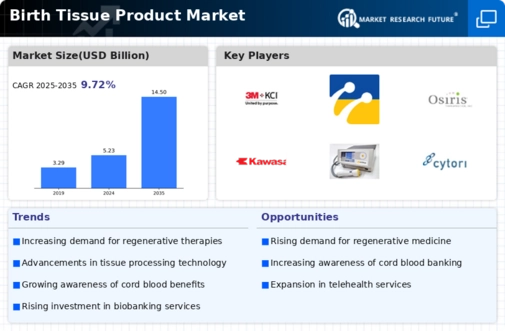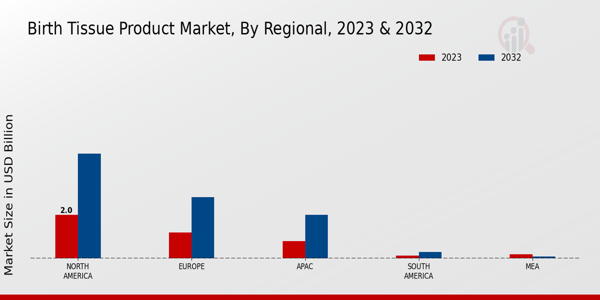Market Growth Projections
The Global Birth Tissue Product Market Industry is projected to grow from 5.23 USD Billion in 2024 to 14.5 USD Billion by 2035. This growth trajectory indicates a compound annual growth rate of 9.72% from 2025 to 2035, reflecting the increasing adoption of birth tissue products in various medical applications. The market's expansion is driven by factors such as rising demand for regenerative medicine, technological advancements, and growing public awareness. As the industry evolves, it is likely to witness further innovations and applications, solidifying its position in the healthcare landscape.
Regulatory Support and Frameworks
The Global Birth Tissue Product Market Industry benefits from supportive regulatory frameworks that facilitate the collection, processing, and storage of birth tissues. Governments and health authorities are increasingly recognizing the importance of these products in healthcare, leading to the establishment of guidelines and regulations that promote safe practices. This regulatory support not only enhances consumer confidence but also encourages healthcare providers to integrate birth tissue products into their services. As regulations evolve to support innovation and safety, the market is likely to experience accelerated growth, aligning with the projected CAGR of 9.72% from 2025 to 2035.
Rising Demand for Regenerative Medicine
The Global Birth Tissue Product Market Industry is experiencing a notable increase in demand for regenerative medicine applications. Birth tissues, such as umbilical cord blood and tissue, are rich in stem cells and growth factors, making them valuable for treating various conditions. As awareness of the potential benefits of these products grows, healthcare providers and patients are increasingly considering them for therapeutic purposes. This trend is expected to contribute to the market's expansion, with projections indicating a market value of 5.23 USD Billion in 2024 and a substantial increase to 14.5 USD Billion by 2035, reflecting a compound annual growth rate of 9.72% from 2025 to 2035.
Increasing Public Awareness and Education
Public awareness regarding the benefits of birth tissue products is steadily rising, positively impacting the Global Birth Tissue Product Market Industry. Educational initiatives by healthcare professionals and organizations are informing expectant parents about the potential uses of umbilical cord blood and tissue. This increased knowledge is likely to lead to higher rates of tissue collection and storage, as families recognize the long-term health benefits for their children. As awareness campaigns continue to proliferate, the market is expected to see a significant uptick in participation, further contributing to the projected growth from 5.23 USD Billion in 2024 to 14.5 USD Billion by 2035.
Emerging Applications in Personalized Medicine
The Global Birth Tissue Product Market Industry is witnessing a surge in emerging applications within personalized medicine. Birth tissues are being explored for their potential in developing tailored therapies for various diseases, including genetic disorders and autoimmune conditions. As research continues to unveil the therapeutic possibilities of these products, healthcare providers are increasingly incorporating them into treatment plans. This trend not only enhances patient outcomes but also drives market growth, as the demand for personalized medicine solutions rises. The ongoing exploration of these applications is expected to contribute significantly to the market's expansion in the coming years.
Technological Advancements in Processing Techniques
Advancements in processing techniques for birth tissues are significantly influencing the Global Birth Tissue Product Market Industry. Innovations in cryopreservation, cellular processing, and storage technologies enhance the viability and usability of birth tissues. These improvements not only increase the efficiency of tissue processing but also expand the range of applications in regenerative medicine. As a result, healthcare facilities are more inclined to adopt these products, leading to a broader acceptance in clinical settings. The ongoing development of these technologies is likely to drive market growth, as they enable better preservation and application of birth tissues in various therapeutic contexts.




















